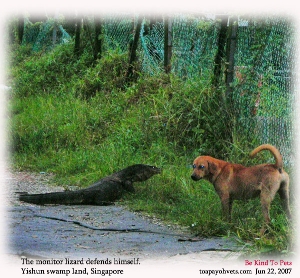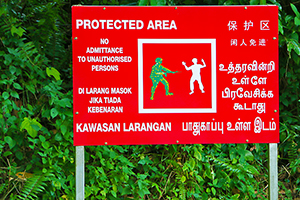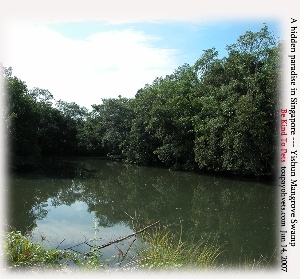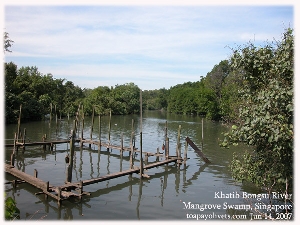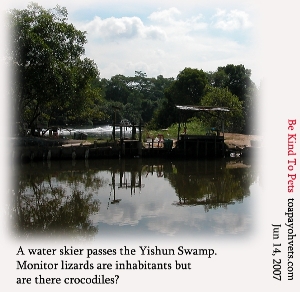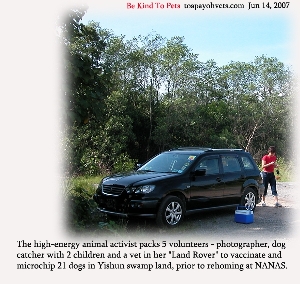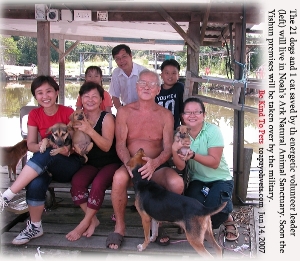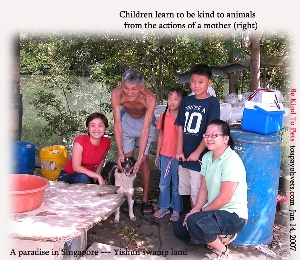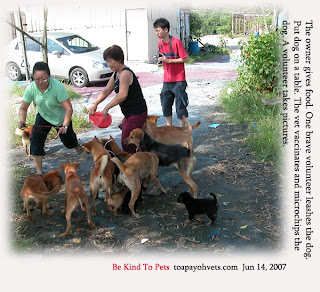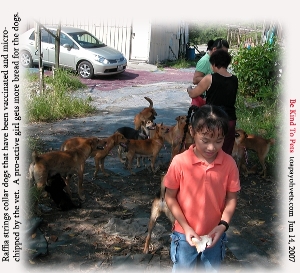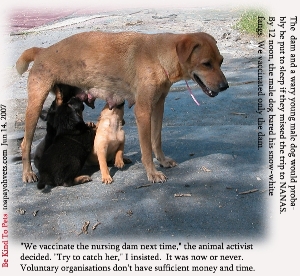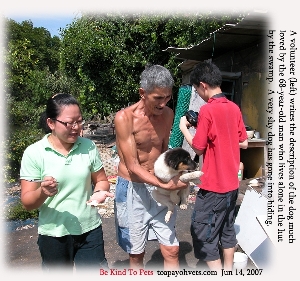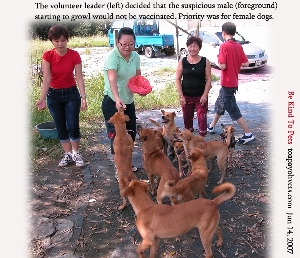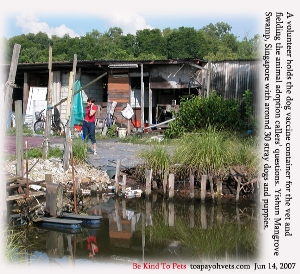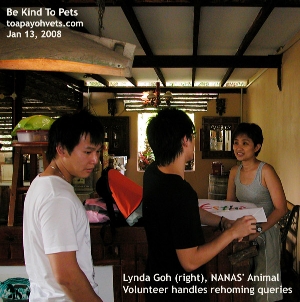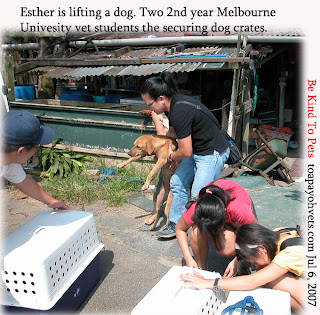Today was surprisingly the same blue-sky bright sunshine and
white-cottony clouded morning almost identical to the weather on June 24,
when I came to vaccinate and microchip the swamp dogs.
At 11 a.m, Lynda drove the volunteers (Esther, myself, 2
second-year Melbourne University vet students and Mr Nick Lee, the dog
photographer) from the Khatib subway to the Yishun Swamp Land to gather 16
dogs and 4 puppies to be transported to Pasir Ris boarding kennel, a
20-minute drive away.
Rick would transport the dogs to the Pasir Ris boarding kennels
today. Another day, the NANAS driver would bring the dogs to NANAS.
Today's Khatib Bongsu River was dry. It was low tide and I could
see the protruding roots of the mangrove trees in the sticky chocolate mud
to our left.
A small group of around 6 men and women suddenly appeared 10
metres to our right as we turned the corner of the pot-holed track. "Look
out," I pointed to the group.
"Are they bandits?" I asked Lynda.
One man appeared to be chopping an object on the granite slab
and the others were eyeing us.
We were in danger? None of us had martial arts training to
defend ourselves and definitely no weapons with us? Lynda should make a
fast U-turn and speed back in such situations. But she slowed down instead
as her SUV dipped into a pot hole.
A man waved his parang (machete) at us. He was a stout person.
He looked intimidating. The jungle track curved her SUV closer to the
group unavoidably.
"They are eating the durians, probably from the fallen durian
trees," I sighed. The two young lady volunteer vet students' heart beats
slowed back to normal.
We reached the fishing pond. The vacated house of Tenant 1 (the
extended family with the patriarch) and the surrounding structures were
run down. Some foreign workers had entered to remove metallic stuff for
sale to scrape yards. Metal prices had shot up in the commodity market.
There were reports of manholes and copper wires being stolen in Singapore.
Catching the dogs would be easy, I thought. Not like the
previous expedition when we needed to entice them with food so that I
could vaccinate them. There were the troublesome nursing dam Lynda finally
caught and a wary suspicious male dog baring his teeth. Lynda decided to
leave him to his fate in Singapore.
Today we seem to have more guns, I mean the manpower. Rick's big
Mercedes van to transport the dogs. Esther, Lynda and the family members
of the patriarch were in full force. The ladies would catch the dogs
without any need for food bribery and put them in Rick's plastic dog
carrier cages.
2 puppies inside one crate were fighting. One puppy yelled
loudly as he was bitten painfully. This play-biting is normal
developmental behaviour in the dog as the biter gets feedback of painful
screams.
"These 2 puppies cannot be crated together," the matriarch's
daughter advised.
A kind 2nd-year vet student separated the 2 puppies and put each
in a different cage.
As many as 3 adult dogs were put inside the large big plastic
dog carrier crate. However, there were many canine escapes.
As Lynda opened one door to put in the 3rd dog, the 2 inside
dashed out at top speed. So, all ladies had to catch them again.
It seemed to be a back-breaking job for the ladies as Lynda and
Esther lifted up the swamp dogs by the armpit, put them backside first
into the upright plastic dog carrier crates. Soon, the crates were full.
What to do now?
"Tie one dog inside the van," Lynda took out a brand new blue
dog collar and leash from her fluorescent green plastic bag. This time she
remembered to bring leashes unlike the previous expedition when she had to
get one from the Tenant.
Esther held up the adult dog by the armpits as high above the
ground as she could. With all her strength. Lynda looped the dog collar
onto and round his neck as if she was lassoing wild horses at a rodeo.
Expertly.
From my camera view finder, I knew she was doing it the wrong
way. I shouted not too loudly: "The collar is too loose. The dog's neck is
too small. He will run away when you put him down on the ground!"
I spoke from bitter experience as I had dogs escaping from the
Surgery because my assistants put on loose collars when exercising the
patients. Sometimes, they were confident as the collar had been fitting
and was used by the dog owner for some time.
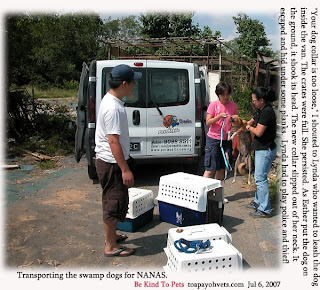
The dog then shakes his head and escapes out of my Surgery. It
is extremely difficult to catch him and it makes the owner unhappy. A
choke chain for restraining dogs would be the preferred collar rather than
the nylon one Lynda was using.
Now Lynda had handled more dogs than anyone of us, I presume.
She collared this dog. Esther put the dog down to let him walk to the van
on a leash. The dog shook his head, the collar rolled out.
He bounced up, not giving one look of respect to the two-legged
homo sapiens. He hunched his shoulders, head lowered and sprinted back to
the house. A flurry of female legs were no match in speed to this
four-legged canine. Now, the ladies were playing "police and thief" while
the dog initiated the game of "hide and seek".
He sank low and dog-crawled under a wooden platform near the
entrance of the house. Into a 6-inch gap and safety. I don't know whether
to laugh out loud as I might offend the volunteers and they might go on
strike. Then I would have to do the job. I wished I was a animal
documentary movie expert as this episode was more comical than words could
describe. Maybe this movie would raise funds for NANAS' animal upkeep.
Discretion is the better part of valour.
"Come out..." a second year vet student bent down and beckoned
to him. With hands on her hips and then off, Lynda did not say anything.
All the dogs sensed something was wrong today. They rolled up
their eyes and the short hairs on their spine were erect. Tails were down.
But they were with the family they knew and loved. So they did not panic.
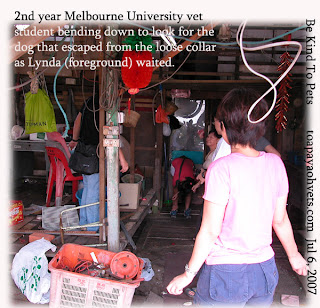
The matriarch persuaded the dog to come out. There was so much
commotion, confusion and noise but the dog was captured.
It would be a dull boring dog-catching morning, I had thought.
But I had a rare chance to get out of my concrete jungle and
visit Singapore's hidden Eden for the last time before the military
acquisition. To smell the roses. To refresh my brain and get out from the
daily routine.
This piece of paradise would be barred to members of the public
once the military staked its claim. Maybe I could spot a monitor lizard
today?
I did not expect a dog-catching day to be so eventful and funny.
But we were all volunteers and could not work with military precision and
planning.
As the dogs from Tenant 1 were crated, Lynda went with the
volunteers further up the track to another area to catch the 2 dogs from
Tenant 2, the 68-year-old man.
I stayed behind to talk to Tenant 1's patriarch. How come he was
still living here using generator to get electricity and bathing in rain
water? Getting bitten by mosquitoes and risking dengue viral fever which
is now endemic in Singapore.
When most Singaporeans have been housed in apartments with water
and electricity easily available at the touch of a switch, this patriarch
and his younger wife lived in a rural area.
According to the patriarch's son-in-law who was in his fifties,
it was around 50 years ago, that the patriarch reclaimed the swamp land.
He was the original land reclaimer, way before the Singapore Government
reclaimed sea land off Beach Road.
Bit by bit he dumped soil. He filled up the swamp to start
shrimp farming. As the years go by, the weather becomes hotter, perhaps
due to global warming. The quality of water from the Khatib Bongsu River
became poorer due to industries being set up nearby. Shrimps started dying
and the whole batch would perish.
He had converted to the fish farming and then he started a
fishing pond. The government offered him short land leases. Tenant 2, the
68-year-old man had worked with him all these years and had stayed alone
further up the track.
I was surprised that there were still old farmers around in
Singapore. Soon Lynda trooped back with the volunteers and the
photographer without dogs.
"The 68-year-old man needed to spend one more night with his 2
dogs," Lynda was sympathetic as the old man would have to live in the
concrete jungle of Singapore's apartments soon. "The dogs would be
transported tomorrow."
Today, 14 dogs and 4 pups were rounded up. As I did not bring my
vaccine this time, I had to find time in the evening to drive to Pasir Ris
to vaccinate a male dog and 4 puppies that Lynda could not find families
to adopt.
"That's the suspicious and nervous male dog you did not
vaccinate," Lynda told me. Lynda did not abandon him to stray or be put to
sleep once the other dogs had been rehomed.
14 dogs and 4 puppies and 2 more dogs tomorrow would live their
natural lives, hopefully to old age, in NANAS. Initially only 21 adult
swamp dogs were selected. I don't know what would be the fate of those
remaining in the Yishun swamp land.
"Why don't you just transport the dogs directly from Yishun
swamp land to NANAS?" I asked Lynda earlier as I thought it was a matter
of vaccination, micro-chipping and putting them straight into a big truck
to to directly to NANAS which is in another country. "Like an army truck
transporting soldiers?"
"I need to do lots of paperwork and make other arrangements.
Some dogs would run away if the NANAS transport man come directly to the
fishing pond." Lynda explained. 24 hours a day were never enough for Lynda
as she had her own work to do and other commitments too.
"It is better to put them in the boarding kennels first. In this
way, NANAS' transport man can take them at his convenience."
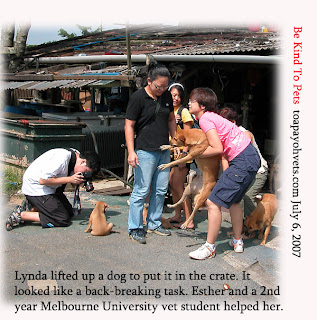
It appeared that all available adult swamp dogs and puppies were
accounted for. Except for one. The leader of the pack called Bobby was a
casualty. He had been warded in a veterinary surgery, apparently from a
chopped tail around one week ago.
Animal volunteers play a big part in making life safer and
better for animals that need help. They are usually youths. They are a
significant help in animal welfare. Their interests usually do not sustain
over time. There is a need to have a pack leader to guide them. This
person must have passion to help animals.
Singaporedoes not have a no-kill animal shelter. So these
cross-bred swamp dogs would pay the ultimate price - death by lethal
injections. Animal shelters in various countries usually need to euthanise
the strays after 1-3 days as there is no space for them and new arrivals
keep flooding in.
It was fortunate that the swamp dogs were introduced by Esther
to a person willing to devote her limited free time to
evacuate them to a no-kill animal sanctuary where they can live out their
natural lives, living free.
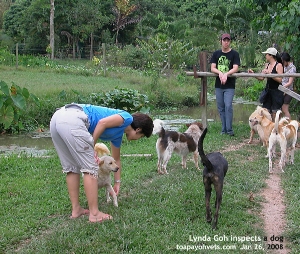
An animal activist with passion is worth more than 40 people merely interested because he or she delivers what is to be done.
